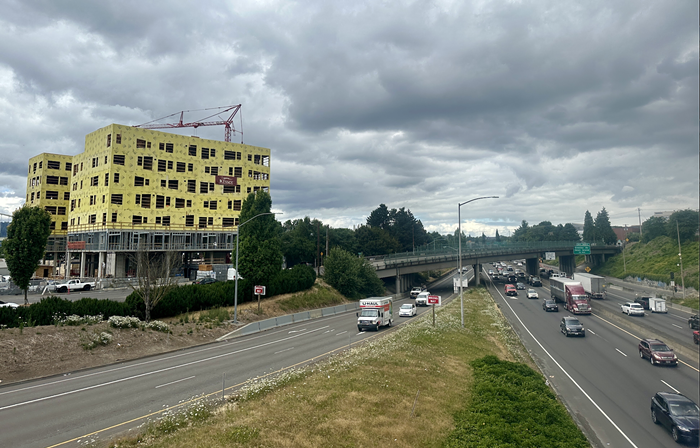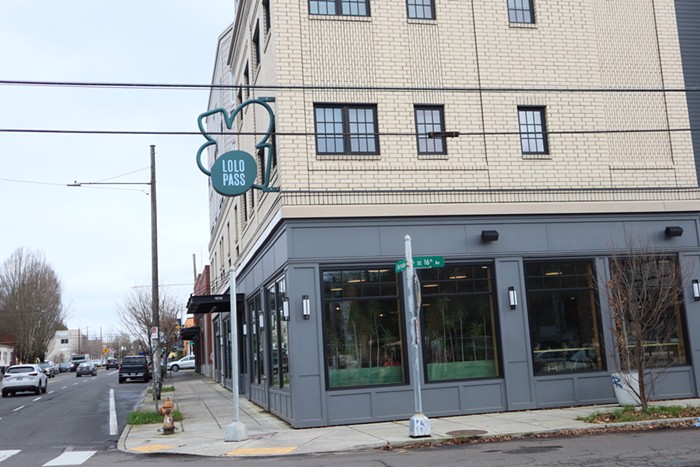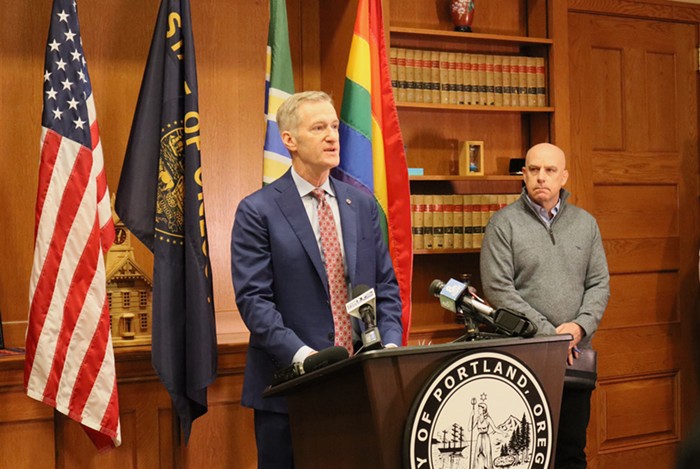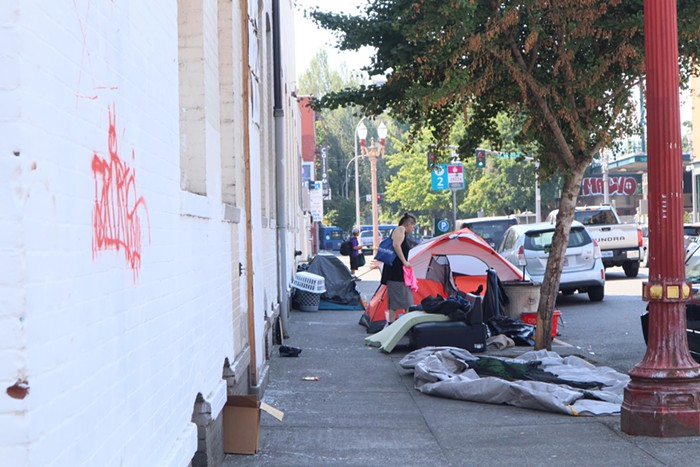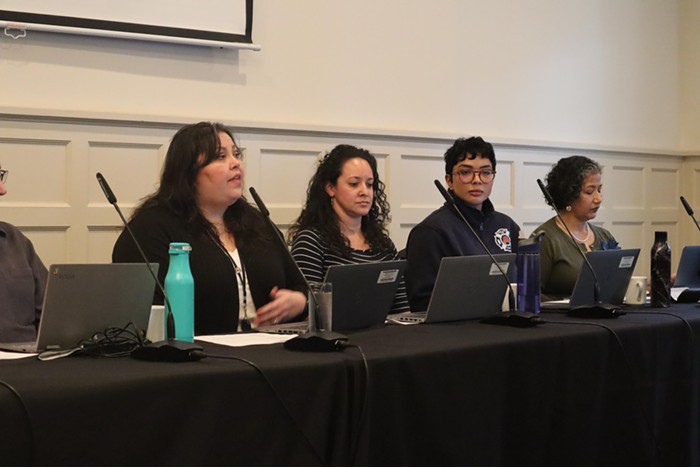Just as dog owners eventually take on the characteristics of their canines, the great philosopher of American politics, Alexis de Tocqueville, once remarked, so do nations and cities begin to reflect their leaders. Certainly this has held true for America over the past eight years, as the pace of life accelerated under Bill Clinton's tireless go-go guard; Clinton, who, like dot-commers, logged all-nighters as a matter of principle. Or take New York City: Mayor Giuliani could go toe-to-toe with the brashest denizens of Manhattan. But how about closer to home? When the city of Portland looks in the mirror, does it see the face of Vera Katz? And vice-versa?
The popular conception is that Katz floated effortlessly into her third consecutive term as mayor on a wave of voter approval. Defeating a slew of hapless opponents in last May's primary, she did not even need to face a general election. Yet this notion belies the fact that Katz gathered only a hair more than 50 percent of the popular vote--just enough to avoid a run-off. A college sophomore with no political experience beyond high school popularity contests and, what's more, was Californian, took a term off from school and paced Katz one vote to her every three. Yes, Katz took 50 percent of the popular vote. But another way to look at those results is that her base of electoral support is only half full.
Portland is a city of dichotomies. While Money magazine voted Portland as the most livable city in the country, we also boast some of the highest rates of hunger, homelessness, and urban poverty in the nation. As commercial centers like the Pearl District and Pioneer Square have blossomed during Katz's eight years in office, the graduation rates of two of Portland's high schools are estimated to be about 50 percent. (Especially alarming considering that two years ago at her State of the City address, Katz promised that she would stand up for Portland's public schools and push them towards the goal of having the "best educated citizens in the nation by the year 2000.")
When Mayor Katz looks into the mirror, she probably does see one side of Portland's face--the side that hangs out at the Schnitz, shops at Nordstrom, and strolls the boutiques of NW 23rd Ave. But, either willfully or negligently, she has ignored the other side of Portland--the half that did not vote for her, but rather voted against her.
On January 26, Katz will take a podium at the downtown Hilton and deliver her ninth State of the City address--officially kicking off her third term. But, in spite of souring economics in some neighborhoods and thousands of struggling families, don't expect good news for the city's most needy that afternoon.
If we can be defined by our choices of friends and enemies, then the mayor's personality is clear. Singling out skateboarders as troublemakers and wielding bans against the most downtrodden in the city--namely, the homeless--Katz has drawn deep dividing lines in the city. Moreover, again and again, she has sided with the Portland Police Bureau. After the now-notorious Kroeker tapes were revealed, she did little more than tap the police chief on the wrist, to the anger and disbelief of the city's large gay and lesbian population. More recently, after revelers on New Year's Eve clashed with 100 police in riot gear, Katz took advantage of several photo-ops, walking alongside controversial Chief Mark Kroeker. Instead of digging through scores of reports of police brutality that stemmed from that evening, Katz focused her attention entirely on scolding rioters for smashing storefront windows.
What follows is the Mercury's own version of the State of the City. And, fellow Portlanders, it is not healthy.
The Vera Katz Memorial Roof
Along SW 5th Ave, a series of five boulders are suspended above the sidewalk by mirrored pedestals. They look like they float. As the sidewalk drops down a small hill, each successive pedestal is slightly taller, so that the rocks are all actually at the exact height above sea level. Along with dozens of other public art works dotting the city's sidewalks, riverfronts, and parks, the floating rocks are a unique and lasting testimony to Mayor Neil Goldschmidt, who initiated a civic program requiring every building project in Portland to return the equivalent of one percent from their capital project to a public art project.
For Mayor Katz, it's the proposed roof over I-405 that will be the memorial to her tenure. Katz and her intensely loyal chief of staff, Sam Adams, are thrilled about the project, which proposes to cover I-405 for the length of several city blocks roughly between Alder and Taylor; essentially, the "roof" will submerge the interstate underneath the city. On top of the roof, Katz has recommended placing office buildings "designed to attract high-tech tenants" on one block, and "market rate" housing on the other. A scale model of the project sits in city hall outside Katz's offices. Already approved by a strategy team appointed by the mayor, Katz has called for construction to begin in 2002.
According to the mayor, the project will rid the city of a lengthy stretch of the unsightly and noisy interstate. (Detractors say that it is just like Katz to try to sweep any ugliness under the carpet--or, in this instance, a $16 million roof.) Katz says the project also will link downtown to the rest of the westside, which has begun to blossom, making more space available for housing and office buildings.
"We're going to run out of land," Katz told the Mercury in a recent interview, "and people are more accepting of development and high density housing in the downtown." She continued, "more importantly it has stirred the imagination of people looking at I-5."
But others feel more shaken than stirred by the idea. High-tech office space and upscale apartments bring to mind similar projects in San Francisco and Seattle, where development has edged out all but the wealthy.
"She looks, I think, for the very easy projects or the extravagantly useless," says Oregonian columnist Steve Duin, one of the few outspoken mainstream media critics of Katz. "Given everything else that needs to be done, the idea of putting a roof over I-405 and focusing on that neighborhood rather than some other neighborhood--say on the eastside--is something I can hardly believe."
While Katz has concentrated on the I-405 roof and commercial development projects, the quality of life for thousands of families--mainly those in the city's inner Northeast and outer Southeast neighborhoodshas plummeted. Like a muscle group that is ignored, housing and jobs for low-income persons in the city have atrophied under Katz's watch. Perhaps the connection to Mayor Katz is not direct. But according to advocates for the city's needy, it's not what she has done, but what she has failed to do. Worse yet, they claim some of her policies have harmed the poorest residents of Portland.
During Katz's tenure, Portland has climbed the rankings of "livable" cities, showing up on listings in Outside magazine, Curve magazine and this past year, scoring the number one position in Money magazine. But, at the same time, the lives of thousands of other Portlanders have worsened. Instead of a rising economic tide raising all boats, the gains for one segment of the population have come at the cost of another.
"Some parts of the city have seen a 200 percent increase in housing costs at a time when the percentage of households in poverty is rising," says Tasha Harmon, Executive Director of the nonprofit Community Development Network. "There's been massive displacement of low-income people already."
Katz has stood as the lead cheerleader for the city's anti-camping ban, a local ordinance that has prodded homeless people out of their resting places. Enacted in 1981, the ordinance pre-dates Katz. Yet, as mayor, Katz has pushed for vigorous enforcement. Recently, when Judge Stephen Gallagher ruled that the ordinance is unconstitutional, Katz publicly threw her support behind the District Attorney's office appeal of the opinion.
In mid-December, a few days before Christmas, 30 or so homeless men set up an encampment beneath the Broadway Bridge. Within 72 hours, the squatters were chased away by Portland police. For the ensuing month, a cat-and-mouse game has played out--with City Hall pressing for enforcement and the homeless trying to stay a step ahead of the police.
The message from City Hall seems clear enough: A roof over commuters' heads on I-405, but not over the needy and the homeless. It is a tale of two very different cities, except that both co-exist within the same urban growth boundary.
The housing problem is most acute in the inner Northeast and Southeast, where property prices have almost doubled over the past decade while paychecks have hardly budged. Metro Council predicts a shortage of 90,000 affordable homes in the next few years.
Sam Adams, Katz's long-time chief of staff, defends the mayor's efforts to stimulate growth in Portland's down-and-out neighborhoods. The mayor created a tax increment district so more money could be directed to urban renewal projects in Northeast, he says. Adams adds that Katz has worked on similar projects in the Lents area. "The bulk of our work happens in the eastside," he insists. "We're building two light rail lines, the light rail to the airport and to Interstate, and we're also completing the Hollywood Town Center plan, and the Williams plan." Adams also points out that Katz does her holiday shopping on MLK Blvd, the main commercial thruway of Northeast.
However, so far the results are dismal. If a cohesive plan exists at all for handling the city's needy, Katz's approach has been two-pronged. The first approach is to create more jobs and the second is to secure housing for low-income families. But, Katz's programs have angered activists more than appeased them.
Best described as the trickle-down theory, the mayor has pushed forward major tax relief for corporations doing business in The City That Works. Over the past five years, one tax-break plan handed $10 million to Oregon Steel and another $7 million to Freightliner, a subsidiary of Daimler-Benz. The theory goes that these tax breaks will serve as incentives for companies to locate in Portland and will be re-invested into creating new jobs and wage increases. However, advocates for workers don't see it that way.
"There isn't any tax break for business the mayor doesn't like," laments Jamie Partridge, who chairs the Living Wage Committee for Jobs for Justice, a coalition of 53 labor and community groups. He argues that the money could be better spent on schools or even on transporting people to jobs in the suburbs.
More pressing, says Partridge, the mayor's program has not been accountable. Freightliner laid off 770 workers and Oregon Steel never even promised to create any jobs--just to keep existing jobs. The company threatened to relocate unless the city gave them the subsidy, says Partridge, and the city just caved in.
Incredibly, until last year the city had no comeback if corporations reneged on their promises of employment and community investment. Now, as quid pro quo for tax breaks, companies must hire from the area with 85 percent of the jobs paying 150 percent of minimum wage. They must also pay a portion of childcare costs, transit fares, and training. If they don't comply the city can demand back the tax breaks.
Even these penalties fail to set up real protections, says Partridge. Companies can manipulate the system and come out on top even if they fail to meet the conditions, indicates Partridge. He is also acutely critical of the decision to drop public hearings on the contracts.
The second prong of Katz's plan to help the needy is equally flaccid. In 1998, she championed a Preservation Ordinance that gives the city first dibs on so-called Section 8 apartment buildings. The motivation behind the plan was to preserve housing for low-income residents; but, say critics, the plan has failed to deliver its promises.
Dozens of apartment buildings around Portland have been under long-term contracts with the federal government to subsidize rent for low-income residents. But, once these contracts expire, building owners are free to do whatever they want with the buildings.
Adams points out that last year the mayor budgeted $5 million to build affordable housing, while another $53 million of tax increment money will be spent on affordable housing in the River district over the next 20 years.
Proposals aside, though, housing advocates have seen few substantive gains from this program. For example, when the Section 8 contracts on the Western Rooms building and two adjacent buildings expired this past autumn, the city failed to buy back the buildings from the owner. They now are being converted to high-rent apartments and shopping malls. As a result, 35 tenants will be turned out of their apartments.
"For every 1000 or 2000 units built in a given year, we'll lose 5,000 to the market," says Harmon. "If all they are willing to do is to commit dollars, that's not good enough."
According to Harmon, Katz should be leading the charge to regulate Portland's housing market. Harmon is part of a chorus of housing advocates pleading for a city tax on property speculation--one that penalizes people who buy houses at low prices and immediately sell them again at a profit. This program would slow gentrification in Northeast Portland by discouraging quick property turnovers.
Harmon also would like to see an inclusionary zoning ordinance that would require developers to build inexpensive housing alongside the "Mcmansions and condos." An ordinance was proposed, but when the Homebuilders Association appealed to the state legislature asking that inclusionary zoning be declared illegal, City Hall simply rolled over.
"There was no significant effort to prevent that tool being taken from us," bemoans Harmon. "The city didn't fight for it."
Although county, state, and federal ordinances and laws are out of Katz's jurisdiction, it is not unheard of for a mayor to stand up for her city. Leaders in similar positions--as the mayors of the largest and most economically important city in a state--have done so for decades. No, the Willamette is not the Hudson, but wouldn't Giuliani stride into the New York state legislature and demand to be heard? Instead, says Harmon, Katz has not stood up for the little guy; she has done nothing.
Heart and Soul of Power
The base of the Mayor Katz's power is--or, should be--City Council. Without the direct control over city services that mayors in many other cities enjoy, her only special power is to delegate various city bureaus, from housing to transportation, to the city commissioners. Otherwise she is only one vote among five on the City Council. Her strength therefore depends upon her ability to forge alliances with the commissioners and set the agenda of the Council. With the amiable, center-leaning cast that makes up the current City Council, this should be a breeze. Yet Katz has had increasing difficulty promoting her agenda--or any agenda, for that matter.
"The mayor doesn't get to be in charge of every initiative," says City Commissioner Charlie Hales. "I think Vera has struggled with this form of government and has occasionally wished out loud she could have a New York-style council where she did have control over the whole enterprise." Hales adds, "She has been the only person in the building who has thought that would be a good idea."
"She has not exploited the advantages of this structure," continues Hales, "which is too bad because she is very personable and capable and she cares a lot about the city."
In late December, Hales led the charge to oust a ban on skateboarding and in-line skates in the downtown district. It was a move that Katz publicly opposed. But, in spite of her opposition and lobbying to maintain the ban, her wishes were overruled 3-2. Over the past few months, Katz has lost a string of battles as City Council has defied her wishes and moved in the completely opposite direction.
Hales and co-Council member Erik Sten say the mayor hasn't pushed hard to rally her team behind her agenda. In Sten's view Katz rarely makes a mistake, but is even less likely to attempt a major plan.
"In terms of making things happen and creating excitement on the council to be bold," he says, "that's her weakest suit." Sten continues: "The interesting thing is, there doesn't seem to be an over-arching strategy or vision as to how to build the new Portland. Why do her successes pale in comparison to the mishaps? She's done a good job on many different projects, but she hasn't articulated the root cause of Portland's problems, tied it to an overarching vision of Portland and excited people."
Sten and Katz have recently butted heads over the issue of police accountability. As mayor, Katz is directly responsible for the Police Bureau. Sten has pressed for a police bureau that operates more openly and with greater opportunities for review. In late December, Katz was so angered by some of Sten's remarks about heavy-handed police tactics at recent protests and the futility of Police Internal Investigations Auditing Committee (PIIAC) that, chief of staff in tow, she stormed into Sten's office.
In 1994, Katz brought PIIAC--a mechanism to review complaints about the police force--into City Hall. But since its inception the group has been an utter failure, doing little more than rubber-stamp the police version of any story and disregarding citizens' complaints of brutality and misconduct. As incidents of heavy-handed policing in Portland have increased, the debate over PIIAC has crescendoed. Seven months ago, a group of citizens forced Mayor Katz to appoint a task force to review PIIAC. (On January 17, City Council considered suggestions made by that group for changes to PIIAC.) If City Council votes to overhaul PIIAC, it will be an insulting slap in Katz's face, essentially declaring that she mishandled perhaps her most important duty over the past six years and, to some degree, is responsible for a police force that has spun out of control.
It would also signal that commissioners are stepping away from Katz--more evidence that she is losing influence. And, like a President or a Governor losing control over the legislature, such separation usually results in legislative paralysis.
It couldn't come at a worse time. The city is standing at a crossroads, with the fortunes of residents running in opposite directions--some toward high-tech nirvana and the Southwest hills, the others toward skid row. Ideological clashes over how the city should be policed show no signs of a quick resolution. Now more than ever, Portland needs an effective, visionary leader to stop our city from going the way of Seattle and San Francisco. But don't expect solutions to these problems from Mayor Katz. With the Mayor's eyes firmly attached to a scale-model roof over I-405 and her back turned to the city's homeless, disenfranchised and needy, it is doubtful she's up to the task.

